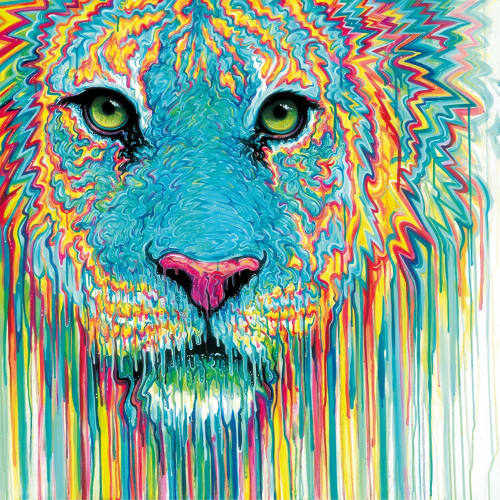
Living in Stockport, Greater Manchester, Robert Oxley is a self-taught artist specialising in low brow pop surrealism.
For as long as he can remember, Robert Oxley has loved painting. He learnt early on that he could impress others with his art when one of his drawings was published in a book called ‘Getting Ready For School’ which was sent to nursery children all over the world. As he grew a little older, his work was influenced by his love of horror movies and rock music, and he would spend all his time drawing monsters and copying album covers.
Robert developed a passion for wildlife, birds and natural history and, longing to be a zoo keeper, he began to make and paint dioramas for imaginary zoos. At around 12 years old, he accepted a challenge from his grandfather to draw all the birds in an illustrated book of birds they both loved, and was a little surprised when his grandfather then arranged an exhibition of them at his work!
Robert attempted an Art A Level in school and a degree later in life, but found both a little too repetitive, and felt he was more advanced than the class tutors. As a result, Robert is entirely self-taught; he says “Everything I know I taught myself from watching and doing, if I saw something I liked I’d try it myself and I never give up on a piece.”
He has gone on to enjoy exhibitions in various galleries throughout the UK, appeared in number publications and was highly commended by the BBC wildlife artist of the year before signing to Washington Green Fine Art.
Robert’s previous work has been primarily photorealistic, natural history painting exploring themes of loss of natural habitat and species extinction. However, having seen the rise of more abstract, surrealist pieces, he has taken a different approach in his more recent work. Immersing himself in pop surrealism, influenced by artists such as Robert Crumb, Glenn Brown and Robert Williams, Robert presents us with what he called a ‘psychedelic natural history’.
He says: “I took a bunch of canvases and with no ideas no references and no vision of a finished painting I just painted and let it happen. As the paintings grew I realised that I wanted something that was loose and expressionistic, yet was controlled and detailed.
“Now 30 paintings in I have a whole new way of working and this has freed me up in many ways. It seems I am distorting images that I have spent years making as real as possible and it feels good.”
Using acrylic on canvas, the approach to Robert’s work is all about being in the moment, the act of making the work and giving himself over to the process and the chemistry which he has nurtured over the years. He wants the work to look like it was made quickly and loosely but on inspection every brushstroke is considered and painted meticulously; something which appears loose and free but in fact is complex which is what nature is all about.


